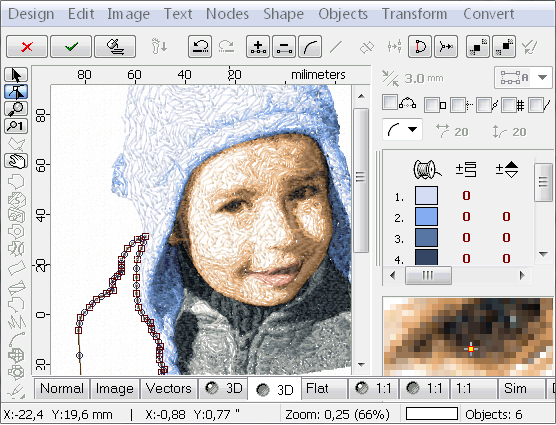Specialist Digitizing for Embroidery: Rapid and Reliable Solution
Specialist Digitizing for Embroidery: Rapid and Reliable Solution
Blog Article
Streamlining the Art of Needlework Digitizing: Step-by-Step Overview
Embroidery digitizing is a meticulous craft that requires precision and creative thinking. As technology continues to development, the digitization process has actually ended up being more obtainable, permitting lovers to bring their complex styles to life easily. In this overview, we will certainly unravel the intricacies of embroidery digitizing, breaking down each step carefully to enhance the process and encourage both novices and seasoned embroiderers alike. Keep tuned to uncover just how you can simplify this intricate art type and transform your imaginative visions into beautifully stitched masterpieces.
Understanding Needlework Digitizing Software Program
Embroidery digitizing software serves as an essential device for transforming detailed designs into digital formats suitable with needlework machines, assisting in precise stitching and personalization. This customized software application permits users to import different picture documents styles, such as JPG or PNG, and convert them right into needlework machine-readable layouts like DST, EXP, or PES - Digitizing for Embroidery. By utilizing features like stitch modifying, underlay choices, and thread color option, digitizing software program allows users to manage every facet of the layout procedure
Moreover, advanced embroidery digitizing software application uses tools for producing complicated styles, readjusting stitch thickness, and including intricate details. Users can also preview the style before stitching it out, guaranteeing accuracy and reducing errors. In addition, several software application supply automated attributes that aid simplify the digitizing procedure, conserving effort and time.
Recognizing the capacities of needlework digitizing software program is important for achieving top quality results in embroidery tasks. By grasping this device, needlework enthusiasts and experts can release their creativity and bring elaborate designs to life with accuracy and performance.

Choosing the Right Design File
After familiarizing on your own with the abilities of embroidery digitizing software program, the following crucial action in the process is choosing the right style declare your task. Digitizing for Embroidery. When picking a layout file for needlework digitizing, it's necessary to consider the complexity of the design, the size of the end product, and the type of material you will be dealing with
For detailed designs with great information, a high-resolution photo or vector file is recommended to guarantee that the embroidery device can properly reproduce the style. In addition, the size of the end product plays a significant duty in selecting the appropriate layout data. Bigger layouts may need greater resolution documents to maintain clarity and intensity.
Moreover, the type of fabric you will be stitching on affects the choice of layout file. Various materials might need changes in the style file to guarantee that the stitches are properly straightened and the design shows up as intended. By carefully selecting the appropriate style file based upon these check out this site aspects, you can establish yourself up for a successful needlework digitizing procedure.
Digitizing Devices and Strategies
Utilizing specialized software program and accuracy techniques, digitizing devices are essential in transforming complex layouts into embroidery-ready data. Needlework digitizing software application, such as Wilcom, Hatch, or Embrilliance, supplies the necessary system to transform artwork into stitch data. These programs supply functions like stitch modifying, padding alternatives, and lettering tools to guarantee the style translates seamlessly onto fabric.
One of the essential methods in digitizing is creating a clear path for the embroidery maker to follow. This entails digitizing each element of the style with accuracy, establishing stitch kinds, thickness, and instructions. By utilizing devices like digitizing tablet computers or software-specific plugins, embroiderers can accomplish a high level of precision in their digitized layouts.
Moreover, grasping the art of rug sewing is essential for creating top quality needlework. Underlay sewing supports the fabric and creates a structure for the layout, guaranteeing that the last item is both aesthetically attractive and lasting. By understanding these digitizing devices and strategies, embroiderers can boost their craft and bring elaborate styles to life with accuracy and efficiency.
Personalizing Stitch Types and Directions
The option of stitch types can substantially affect the browse around this web-site general appearance and structure of the stitched layout. By purposefully incorporating these stitch types, embroiderers can achieve depth and measurement in their layouts.
In addition, the direction of stitches plays a critical duty in improving the visual allure of the last needlework. By trying out with various stitch angles and patterns, embroiderers can bring their layouts to life with exceptional detail and details.
Screening and Refining Your Digitized Layout
To make sure the precision and quality of your digitized style, detailed screening and improvement are vital actions in the embroidery digitizing process. When you have finished the digitization of your style, it is important to examine it before proceeding with the real embroidery. Testing enables you to determine any prospective issues such as string breaks, stitch thickness problems, or style distortions that might influence the outcome.

After testing, it is necessary to refine your digitized style based upon the responses from the test sew-out. This may entail tweaking stitch setups, changing densities, or making modifications to the general design to attain the desired end result. By repeating with screening and refinement, you can adjust your digitized design to excellence before progressing with the real embroidery procedure.
Final Thought
Finally, mastering the art of embroidery digitizing requires a comprehensive understanding of the software, selecting the ideal layout data, utilizing digitizing devices and methods, customizing stitch kinds and directions, and testing and refining the digitized style. By adhering to these steps, embroiderers can streamline the digitizing process click here for more and develop top notch embroidered styles with accuracy and effectiveness.
Report this page